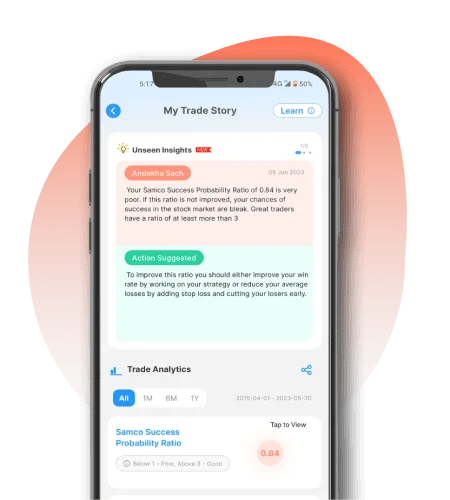A demat account is essential to invest in the Indian stock market. It holds your securities electronically and makes it easier to manage investments. As a demat account holder, you receive a statement displaying details of your holdings and the various transactions you make on the stock exchanges periodically.
The demat account statement might seem confusing at first, especially with all the numbers and different terms involved. However, understanding the demat statement becomes easier if you know what the various terms mean. In this guide, you will learn how to read a demat account holding statement clearly and confidently.
What is a Demat Account Statement?
A demat account statement is a summary of all the demat account activities over a certain period. It is issued by depositories like the National Securities Depository Limited (NSDL) or Central Depository Services Limited (CDSL) through your depository participant (DP).
The statement consists of two parts: the holding statement and the transaction statement. The demat holding statement shows all the securities you currently own in your demat account. The transaction statement, meanwhile, lists all buy and sell activities over a period. This is one of the reasons why the demat account statement is also known as the Combined Account Statement (CAS).
You typically receive the demat account holding statement every month if there are any transactions. Otherwise, you will receive it once every quarter. That said, you can also request the statement anytime to monitor your holdings more frequently.
Key Components of a Demat Account Statement
Understanding the terms used in your demat account holding statement allows you to interpret it more accurately and stay in control of your portfolio.
- Client ID and DP ID: The client ID is your personal unique identifier, whereas the DP ID identifies your depository participant. Together, they help the depositories route your securities accurately and securely to your account.
- BO (Beneficial Owner) details: These are your personal details as the rightful owner of the securities. Your name, address, contact information and PAN are typically listed here.
- Statement Date and Period: The statement date and period help you know exactly what timeframe the data reflects. This is particularly useful for tax filing, financial planning and reviewing activity within specific months or quarters.
- ISIN (International Securities Identification Number): Each security listed on a stock exchange is assigned an International Securities Identification Number (ISIN), which is a globally recognised code for precise identification. The ISIN helps you distinguish between different securities within your NSDL or CDSL demat statement.
- Name of security: This refers to the exact name of the asset you hold, like a company’s shares or a mutual fund scheme.
- Quantity held: This shows how many units or shares of each security you own. It is crucial for tracking your investments and making informed decisions.
- Transaction details: This section lists all purchases, sales and transfers that occurred within the statement period. It gives you a complete history of activities, helping you verify trades.
- Pledged securities (if any): If you have pledged any securities as collateral for a loan, the details of such securities will be listed here. The investments in this section are locked and unavailable for trading or transfer.
How to Read a Demat Statement
Let us assume you purchased 100 shares of a company. This will show as a “credit” in your demat statement. Now, if you sell 40 shares of that company, that appears as a “debit” in your statement. Each purchase and sale entry shows the ISIN of the security, transaction date and traded quantity, helping you track all activity clearly.
After each transaction, the quantity of remaining shares is updated as the balance. For example, after the purchase transaction, the balance in your demat account would be 100 shares. After the sale transaction, the balance would have dropped to 60 shares (100 shares - 40 shares). Your demat account statement makes it easy to compare previous and current balances to assess any changes in your portfolio.
Importance of the Demat Account Statement
Your demat account statement is more than just a record of your holdings. Here are some reasons why it is significant.
- For tracking investments: It helps you monitor what securities you own, how much of each, and when you bought or sold them.
- For income tax filing: Capital gains or losses are calculated from your buy and sell transactions. Your demat account holding statement simplifies tax filing by providing accurate transaction data.
- To detect unauthorised transactions: By reviewing your NSDL or CDSL demat statement regularly, you can quickly spot any suspicious activity and raise concerns with your broker or DP immediately.
- For portfolio rebalancing: Rebalancing ensures your investments stay aligned with your goals. Your demat statement provides the information you need to shift between asset classes as required.
Common Errors and How to Resolve Them
Your demat account statement is generally reliable. However, occasional errors may occur. Here is how to identify and fix the most common issues.
- Mismatch in holdings: If the holdings in your demat statement do not match your actual trades, contact your broker or DP to reconcile the difference immediately.
- Unfamiliar transactions: If you spot a trade or transfer you did not make in your NSDL or CDSL demat statement, report the discrepancy to your DP immediately and freeze the account to prevent further misuse.
- Incomplete information: Missing ISIN or quantities in your demat statement should be flagged with your depository participant for prompt rectification and record updation.
How to Download Your Demat Statement
If you are a Samco user, you can easily access your demat account statement anytime to track or verify your holdings. Here is how to download it quickly.
- Step 1: Visit the Samco Star Back Office portal and log in to your account.
- Step 2: Click ‘Portfolio’ on the left side menu and then on ‘Holdings’.
- Step 3: Click the ‘Download’ button to download the demat account holding statement.
Alternatively, you can also download your demat statement by visiting the CAS portal of NSDL or CDSL. Log in to your account with your PAN, BO ID and date of birth. You can view and download your demat account statement directly from the portal.
Conclusion
The demat account statement is essential for staying in control of your investments. You must check your statement every month, especially if you trade regularly. Periodic checks can help you track performance, file taxes accurately and catch errors early. If you need help reading your statement or spotting issues, you can always contact the Samco support team for assistance.








 Easy & quick
Easy & quick